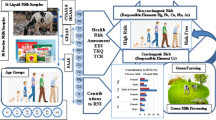Abstract
Molybdenum is an essential trace nutrient in the human diet. Our purpose was to provide a comprehensive analysis of Mo content of various types of powdered infant formulas across Canada and the USA. All infant formulas, available on the day of sampling, were purchased from random supermarkets in Grand Forks, ND, USA; San Diego, CA, USA; Washington, DC, USA; and Winnipeg, MB, Canada. Reference powdered milk, human milk (HM), and formula samples were weighed and acid-digested prior to analysis by graphite furnace atomic absorption spectroscopy. Mo content in all formulas ranged from 15.4 to 80.3 μg/L (mean ± SE, 37.7 ± 1.7 μg/L). HM Mo concentration ranged from 1.5 to 9.5 μg/L (5.09 ± 0.81 μg/L). Formulas intended for full-term or for premature infants feeding contained, on average, more Mo than HM. Formulas intended for infants with special needs contained similar mean Mo levels to HM. No significant differences were detected between mean Mo values of formulas of a same type purchased from different brands and/or at different locations. High Mo intake may pose health risks, despite lower bioavailability of Mo from formula compared with HM.

Similar content being viewed by others
References
Institute of Medicine (2000) Dietary Reference Intakes for vitamin A, vitamin K, arsenic, boron, chromium, copper, iodine, iron, manganese, molybdenum, nickel, silicon, vanadium, and zinc. National Academy, Washington, DC
Institute of Medicine (2006) Dietary Reference Intakes: the essential guide to nutrient requirements. National Academy, Washington, DC
Abumrad NN, Schneider AJ, Steel D et al (1981) Amino acid tolerance during prolonged total parenteral nutrition reversed by molybdate therapy. Am J Clin Nutr 34:2551–2559
European Commission, Health and Consumer Protection Directorate (2000) Opinion of the Scientific Committee on Food on the tolerable upper intake level of molybdenum. Available at: http://ec.europa.eu/food/fs/sc/scf/out80h_en.pdf. Accessed 21 May 2009
World Health Organization (1996) Trace elements in human nutrition and health. World Health Organization, Geneva
Sievers E, Dorner K, Garbe-Schonberg D et al (2001) Molybdenum metabolism: stable isotope studies in infancy. J Trace Elem Med Biol 15:185–191
Sievers E, Oldigs H, Dorner K et al (2001) Molybdenum balance studies in premature male infants. Eur J Pediatr 160:109–113
Turnlund JR, Keyes WR, Peiffer GL (1995) Molybdenum absorption, excretion, and retention studied with stable isotopes in young men at five intakes of dietary molybdenum. Am J Clin Nutr 62:790–796
Sievers E, Schleyerbach U, Arpe T et al (2001) Molybdenum supply of very low-birth-weight premature infants during the first months of life. Biol Trace Elem Res 80:97–105
Eisler R (2000) Molybdenum. In: Handbook of chemical risk assessment: health hazards to humans, plants, and animals, vol 3. CRC, Boca Raton, pp 1613–1641
Sievers E, Arpe T, Schleyerbach U et al (2000) Molybdenum supplementation in phenylketonuria diets: adequacy in early infancy? J Pediatr Gastroenterol Nutr 31:57–62
Meinel B, Bode JC, Koenig W et al (1979) Contents of trace elements in the human liver before birth. Biol Neonate 36:225–232
Australia New Zealand Food Authority (2002) Proposal P93—review of infant formula. Available at: http://www.foodstandards.gov.au/_srcfiles/P93_SuppFAR.pdf. Accessed 15 May 2009
Department of Justice Canada (2009) Food and Drug Regulations—Food and Drug Act: Division 25. Available at: http://laws.justice.gc.ca/en/showdoc/cr/C.R.C.-c.870/bo-ga:l_B-gb:s_B_25_001//en#anchorbo-ga:l_B-gb:s_B_25_001. Accessed 15 May 2009
US Food and Drug Administration (2004) Federal Food, Drug, and Cosmetic Act—Section 412: requirements for infant formulas. Available at: http://www.fda.gov/opacom/laws/fdcact/fdcact4.htm#sec412. Accessed 15 May 2009
Ikem A, Nwankwoala A, Odueyungbo S et al (2002) Levels of 26 elements in infant formula from USA, UK, and Nigeria by microwave digestion and ICP-OES. Food Chem 77:439–447
Friel JK, MacDonald AC, Mercer CN et al (1999) Molybdenum requirements in low-birth-weight infants receiving parenteral and enteral nutrition. J Parenter Enteral Nutr 23:155–159
Bougle D, Bureau F, Foucault P et al (1988) Molybdenum content of term and preterm human milk during the first 2 months of lactation. Am J Clin Nutr 48:652–654
Casey CE, Neville MC (1987) Studies in human lactation 3: molybdenum and nickel in human milk during the first month of lactation. Am J Clin Nutr 45:921–926
Biego GH, Joyeux M, Hartemann P et al (1998) Determination of mineral contents in different kinds of milk and estimation of dietary intake in infants. Food Addit Contam 7:775–781
Hattori H, Ashida A, Ito C et al (2004) Determination of molybdenum in foods and human milk, and an estimate of average molybdenum intake in Japanese population. J Nutr Sci Vitaminol 50:404–409
Bougle D, Foucault D, Voirin J et al (1991) Molybdenum in the premature infant. Biol Neonate 59:201–203
Lopez-Garcia I, Vinas P, Romero-Romero R et al (2007) Liquid chromatography–electrothermal atomic absorption spectrometry for the separation and preconcentration of molybdenum in milk and infant formulas. Anal Chim Acta 597:187–194
Society CP, Committee N (1995) Nutrient needs and feeding of premature infants. Can Med Assoc J 152:1765–1785
World Health Organization (2009) Child growth standards—weight-for-age. Available at: http://www.who.int/childgrowth/standards/weight_for_age/en/index.html. Accessed 21 May 2009
Hunt CD, Meacham SL (2001) Aluminum, boron, calcium, copper, iron, magnesium, manganese, molybdenum, phosphorus, potassium, sodium, and zinc: concentrations in common Western foods and estimated daily intakes by infants; toddlers; and male and female adolescents, adults, and seniors in the United States. J Am Diet Assoc 101:1058–1106
Acknowledgments
This study was supported by funding from the Canadian Institutes of Health Research and the Manitoba Institute of Child Health.
Conflict of Interest
There is no conflict of interest for any author.
Author information
Authors and Affiliations
Corresponding author
Rights and permissions
About this article
Cite this article
Abramovich, M., Miller, A., Yang, H. et al. Molybdenum Content of Canadian and US Infant Formulas. Biol Trace Elem Res 143, 844–853 (2011). https://doi.org/10.1007/s12011-010-8950-4
Received:
Accepted:
Published:
Issue Date:
DOI: https://doi.org/10.1007/s12011-010-8950-4



